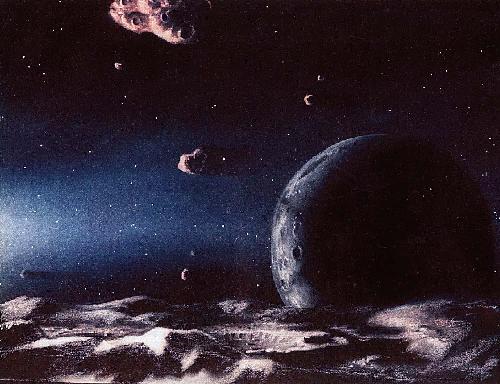
| Comet 332P/Ikeya-Murakami Breakup |
|---|
In a
Nutshell
We have obtained the best ever observations of a comet breaking up. We used
the Hubble Space Telescope to measure the sizes and speeds of ejected material,
finding that the breakup was recent and that rotational breakup driven by outgassing torques is the likely cause.
Breakup, rather than steady loss of ice, may be the leading cause of
the demise of comets.
Comets survive for the age of the solar system in the deep freeze of
the Kuiper belt but, once deflected near the
Sun, quickly begin to decay.
Abstract
We present initial time-resolved observations of the split comet
332P/Ikeya- Murakami taken using the Hubble Space Telescope. Our images
reveal a dust- bathed cluster of fragments receding from their parent
nucleus at projected speeds in the range 0.06 to 3.5 m/s from which
we estimate ejection times from October to December 2015. The number of
fragments with effective radii >20 m follows a differential power law
with index gamma = -3.6+/-0.6, while smaller fragments are less abundant than
expected from an extrapolation of this power-law. We argue that, in
addition to losses due to observational selection, torques from
anisotropic outgassing are capable of destroying the small fragments by
driving them quickly to rotational instability. Specifically, the
spin-up times of fragments <20 m in radius are shorter than the time
elapsed since ejection from the parent nucleus. The effective radius of
the parent nucleus is < 275 m (geometric albedo 0.04 assumed). This
is about seven times smaller than previous estimates and results in a
nucleus mass at least 300 times smaller than previously thought. The
mass in solid pieces, 2x10**9 kg, is about 0.04 of the mass of the parent
nucleus. As a result of its small size, the parent nucleus also has a
short spin-up time. Brightness variations in time-resolved nucleus
photometry are consistent with rotational instability playing a role in
the release of fragments.

CAPTION: 332P on UT 2016 January 26, 27 and 28, showing fragments measured in this work. The images are displayed consecutively as an animated gif in order to show the motion of the fragments relative to the parent nucleus (visible as the bright object to the lower left). The actual motions are very slow, of order 1 m/s, and show a fan-like divergence from the parent. Notice that some of the fragments also change in brightness and even shape from day to day. We think this is due to continuing outgassing, rotation and breakup of the fragments.
From Jewitt et al 2016, Astrophysical Journal.
Blink Movie as a stand-alone gif.
Figures from the paper:
Figure 1 Figure 2 Figure 3 Figure 4 Triple Figure
Our paper describing this work is linked here.
Contact David Jewitt [jewitt@ucla.edu 301-825-2521]
 |
 |
|
| Comet | Jewitt | Kuiper |
|---|